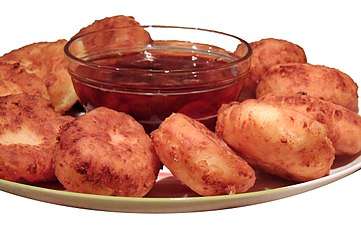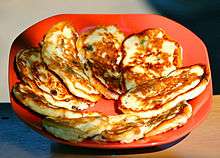Syrniki
 Syrniki served with strawberry varenye | |
| Alternative names | Syrnyky |
|---|---|
| Type | Pancake |
| Associated national cuisine | Belarusian, Lithuanian, Polish, Russian, Serbian, Ukrainian |
| Main ingredients | Quark cheese, flour, eggs, sugar; sometimes raisins, vanilla extract |
In Ukrainian, Russian, Belarusian, Latvian, Lithuanian and Serbian cuisine, syrnyky (Ukrainian: сирник[и]; Russian: сырники; Belarusian: сырнікі) are fried quark pancakes, garnished with sour cream, varenye, jam, honey or apple sauce. The cheese mixture may contain raisins for extra flavour. In Russia, they are also known as tvorozhniki (творо́жники).

Syrnyky or tvorozhniki is made from creamy tvorog (творог, quark), mixed with flour, eggs, and sugar, sometimes adding vanilla extract.[1] Pot cheese or farmer's cheese is suggested as a substitute for the tvorog.[1] The soft mixture is shaped into cakes, which are fried in vegetable oil[2] or hot butter.[3] The consistency should remain creamy,[4] while they are slightly browned on both sides.[5] They are traditionally sweet[3] and served for breakfast or dessert,[6] but can be made savory as well.[1] Their simplicity and delicious taste have made them very popular in Eastern Europe. They are typically served with jam, varenye, sour cream, and or melted butter.[1][2]
The name syrniki is derived from the word syr (сир), which now generally means "(yellow) cheese" in Russian, but once stood for soft white cheese.[7][8] The Ukrainian language retains the old Slavic sense of the word, as in "domashnii syr (домашній сир)", whereas in Russian, the word for white cheese shifted to tvorog (творог).
See also
References
- 1 2 3 4 Mendelson, Anne (2008), Milk: The Surprising Story of Milk Through the Ages, Alfred A. Knopf, pp. 307–308
- 1 2
Lyakhovskaya, L. (Ляховская, Л ) (1996), Pravoslavnaya obryadovaya kukhnya Православная обрядовая кухня [Orthodox ritual kitchen], Leyla Лейла, p. 606,
Подавать сырники горячими со сметаной, вареньем, джемом к чаю, молоку, соку (Serve cakes hot with sour cream, varenye, jam and tea, milk, juice.)
- 1 2 Sacharow, Alla (1993), Classic Russian Cuisine: A Magnificent Selection of More Than 400 Traditional Recipes, Alfred A. Knopf, p. 281 ISBN 1-55970-174-9
- ↑ Jones, Catherine Cheremeteff (2013), A Year Of Russian Feasts, Random House, p. 82
- ↑ Schecter, Jerrold L.; Schecter, Leona P. (1988), Back in the U.S.S.R.: An American Family Returns to Moscow, Scribner, p. 14
- ↑ Henry, Diana (2016), Roast Figs, Sugar Snow: Food to Warm the Soul, Octopus Books, p. 50 ISBN 1784723312
- ↑ Aslanov, Cyril (1999), "La réflexion linguistique hébraïque dans l'horizon intellectuel de l'occident médiéval Essai de comparaison des traités de grammaire hébraïque et provençale", Bulletin de la Société de Linguistique de Paris, 94: 28 , citing K. B. Baburina (97, 3, 48– 52)
- ↑ Kess, Inga Инга Кесс (2005). "The origin of words. Names of common dishes and individual products" Происхождение слов. Названия распространенных блюд и отдельных продуктов. Archived from the original on 2008-12-08.
External links
| Wikibooks Cookbook has a recipe/module on |
- Michele A.Berdy's syrniki recipe - Rossiyskaya Gazeta
- https://natashaskitchen.com/2012/02/16/ukrainian-syrniki-recipe/
- http://allrecipes.co.uk/recipe/41849/syrniki-russian-cheese-pancakes.aspx
- https://www.sainsburysmagazine.co.uk/recipes/breakfasts/syrniki
- https://www.npr.org/2011/07/20/138515555/syrniki-curd-cheese-pancakes